Central Projects
This topic describes how to work with Central projects in Leapfrog Geo. It is divided into:
- Viewing a Project’s History
- Sharing Projects
- Downloading a Local Copy of a Project
- New Central Projects
The Central Servers panel in the Central Projects tab shows all the Central servers you have access to. The Central servers you connect to are set up via your Seequent ID.
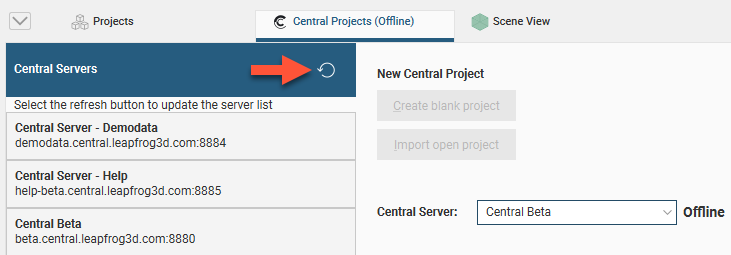
If a server you expect to see does not appear in the list, click the refresh button (![]() ).
).
Click on a server description to connect to it.
Leapfrog Geo version 6.0 is compatible with Central Server version 4.0. If you get a message saying that the version of Leapfrog Geo you are using is not compatible with the Central Server you are trying to connect to, follow the instructions in the message, then try connecting again.
When you are connected to a Central server, there is an Open Portal button that will open the Central user portal in a browser window:
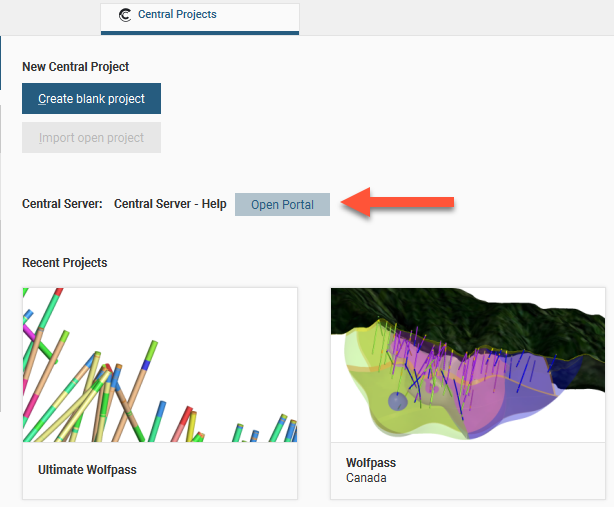
Viewing a Project’s History
See Projects, Revisions, Branches and Nodes in the Central help for an overview of how Central projects are organised.
Once you’re connected to a Central server, the Central Projects tab shows thumbnails of all the projects you have access to. Use the search bar to narrow down the list of projects displayed.

Projects will be organised by location if there are multiple projects at a given location; otherwise projects will simply appear in a list. If a project you expect to see is not listed, click the Refresh button (![]() ) in the Central Servers part of the Central Projects tab. This will refresh the list of projects for the server you are connected to.
) in the Central Servers part of the Central Projects tab. This will refresh the list of projects for the server you are connected to.
A project’s location is set in the Central Portal. You cannot change its location from Leapfrog Geo.
Click on a project to view its history, which will open in a new tab.
Central projects are organised into revisions and branches:
- Different points in the modelling process are captured as revisions, which are specific points in time.
- A revision can be the basis for a new branch, exploring an alternative hypothesis.
These are displayed visually in a project’s history tab, with local copies of projects shown in the panel at the top of the tab:

Each local copy is numbered so that it can easily be seen what versions have local copies in the Local column. The number in the column corresponds to the project in the Local copies panel. You can also:
- Click a thumbnail to open a local copy.
- Click the branch/copy number button (
 ) to identify the parent version of the local copy in the project history.
) to identify the parent version of the local copy in the project history. - Click the Publish button (
 ) to publish the copy being edited to Central.
) to publish the copy being edited to Central. - Click the Delete button (
 ) to delete a local copy, if the project is not open.
) to delete a local copy, if the project is not open.
In the Project history, revisions are displayed chronologically, from the most recent down to the oldest. In the Graph, offshoots from a revision are branches where an alternative hypothesis has been investigated. Changes made in a branch do not appear in other branches; branches effectively diverge from the base revision. The dots on the graph line up with the revision information.
To view more information about a revision, click on it in the history.
Locking Branches
When working on a branch in Leapfrog Geo, the branch can be locked so no other Central users can make changes to it. This is useful for letting others users know that a model is being worked on.
The Locked column indicates whether or not the branch is available to be worked on. If a branch is locked, hold the cursor over it to see who locked it and when it will be available once again.
To lock a branch, right-click on it in the project history and select Lock branch:
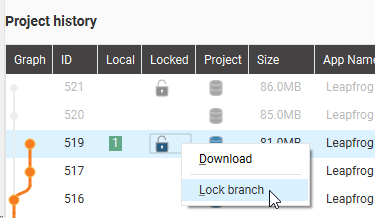
In the window that appears, set the Lock duration and add any comments. The lock can be set for as little as one day; when the lock expires or when a new publish is completed, the branch will be unlocked for other users. While the branch is locked, other users are still able to download projects, create new branches and publish to branches that are not locked.
If you locked a branch, you can unlock it before the lock expires by right-clicking on it and selecting Unlock branch:
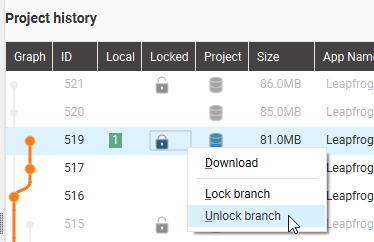
You can also ask your Central administrator to unlock a branch.
Project Included
The Project column indicates whether or not the Leapfrog Geo project was included when the revision was published. If there is no icon displayed, then no project was uploaded when the revision was published. You can view the revision in the Central Browser, but you cannot work on it in Leapfrog Geo.
When Leapfrog Geo projects are included in a revision, they can be published in a Complete state (![]() ) or in an Unprocessed state (
) or in an Unprocessed state (![]() ). The difference between the two is whether or not stored modelling calculations are included in the published project. Removing stored modelling calculations can make the upload/download size of a revision considerably smaller and is useful when internet connectivity is poor. The tradeoff is that when the project is downloaded by a Leapfrog Geo user, the project will have to be reprocessed before they can use it. This may take some time.
). The difference between the two is whether or not stored modelling calculations are included in the published project. Removing stored modelling calculations can make the upload/download size of a revision considerably smaller and is useful when internet connectivity is poor. The tradeoff is that when the project is downloaded by a Leapfrog Geo user, the project will have to be reprocessed before they can use it. This may take some time.
Project Stages
The Project Stage is useful for promoting projects through an organisation’s procedures. For example, your organisation may have project stages defined that include “Experimental”, “Ready for Peer Review” and “Ready for Production”. Different stages are displayed in different colours so it is easy to see at a glance what revisions belong to each stage.
Comments and Attachments
With comments, Central Browser and Leapfrog Geo users can carry out conversations about specific aspects of the model. Comments include a scene. If you already have the project downloaded and open in Leapfrog Geo, you can load the current version of the object referred to by the comment. Click on the scene; you will be prompted to load all the objects or only the unchanged objects:
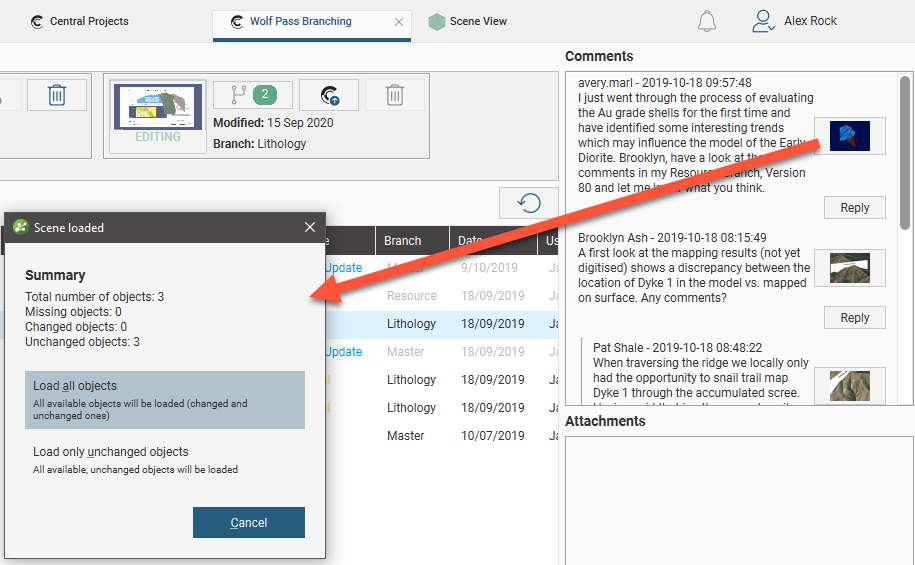
If the selected scene has a geotag, it will be added to the shape list and displayed in the scene.
If the project is not open, the scenes shown in comments will be greyed out:
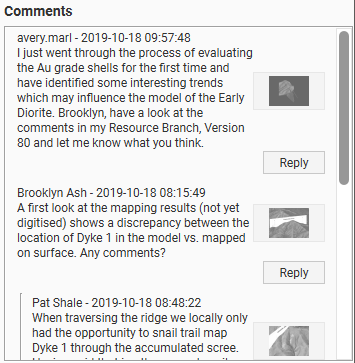
Central Browser users can also attach files, which can be downloaded in Leapfrog Geo.
Sharing Projects
If you are a project’s owner, you can share it with other Central users by clicking the Share Project button in the project’s history tab:

Clicking Share Project opens the Central Portal, displaying the list of users for that project:
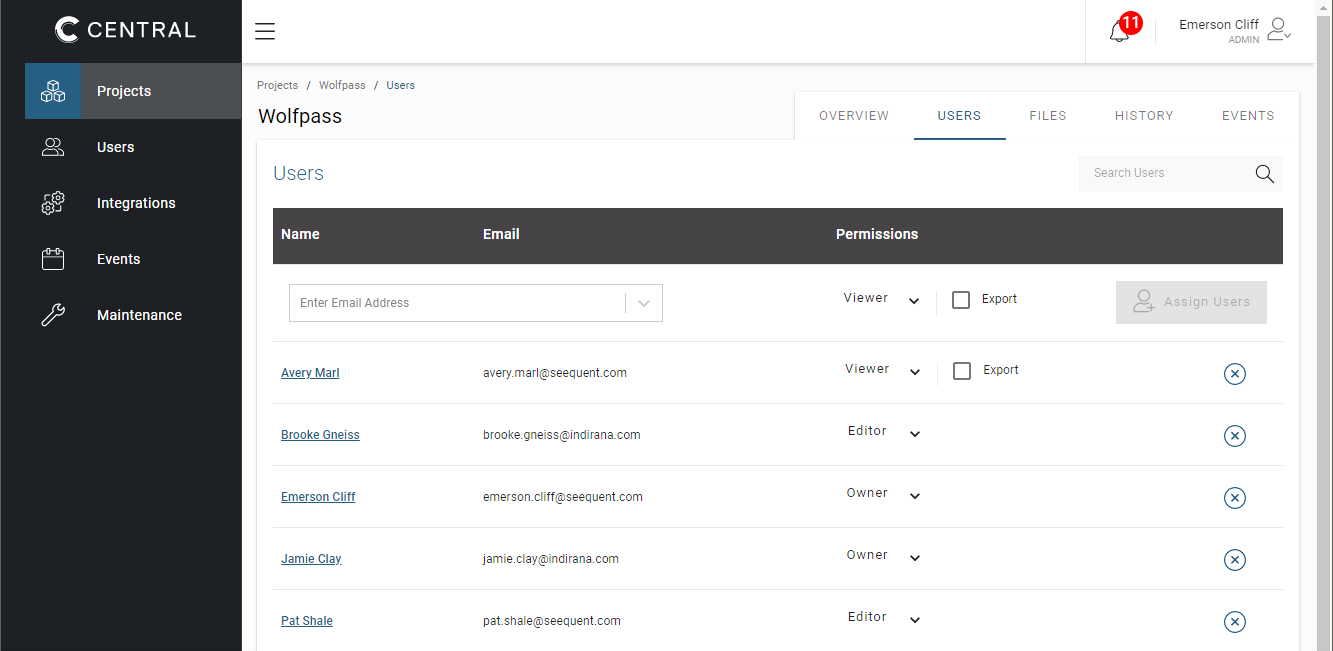
You may need to sign in to the Portal.
You can select from the other users in the system or enter a user’s email address, then assign their permissions.
There are four levels of project permissions in Central: Owner, Editor, Viewer+Export and Viewer.
An Owner can:
- Assign other users as the owner. A project can have more than one owner.
- Configure and add an integration to a project they own.
A user who uploads a new project to Central is automatically assigned as the project owner.
Editor access allows a user to work in a project in Leapfrog.
Viewer+Export access allows a user to open a project in the Central Browser and export data from the project.
Viewer access allows a user to open a project in the Central Browser and make annotations. They cannot export data from the project.
Downloading a Local Copy of a Project
Select a revision and then click Download to download a local copy of the project. The project will be downloaded to the location on your local drive specified in the Settings > Central window. A new revision of the project will be created in the history, as an unpublished project.
Click the Open button in the Local copies panel to open the project:

Work in the project as you would any other Leapfrog Geo project.
New Central Projects
There are two options for putting a project into Central:
- Create a new Central project.
- Put an existing project into Central.
Creating a New Central Project
Use this option to create a new Leapfrog Geo project and put it into Central. In the Central Projects tab, click Create blank project. Enter a name for the project and click OK. A new Leapfrog Geo project will be created and saved in the location on your local drive specified in the Settings > Central window.
Work in the project as you would any other Leapfrog Geo project. When you are ready to publish the project to Central, click on the Central button in the lower left-hand corner of the screen and select Publish:
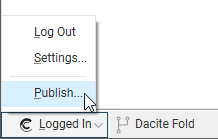
Adding a Project to Central
Use this option to add an existing project to Central.
Open the project you wish to import, then in the Central Projects tab, click Import open project. Enter a new name for the project, if you wish, then click OK. The project will be opened and copied to the location on your local drive specified in the Settings > Central window.
Work in the project as you would any other Leapfrog Geo project. When you are ready to publish the project to Central, click on the Central button in the lower left-hand corner of the screen and select Publish.
Got a question? Visit the Seequent forums or Seequent support